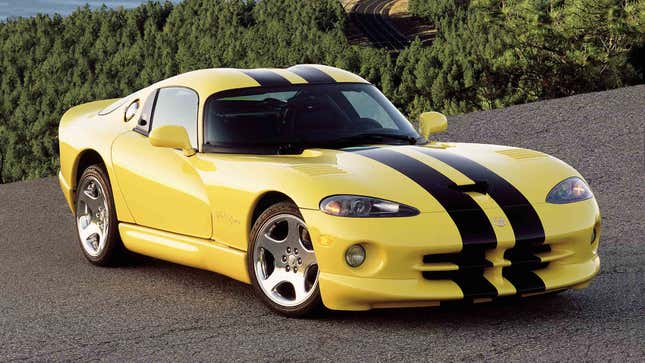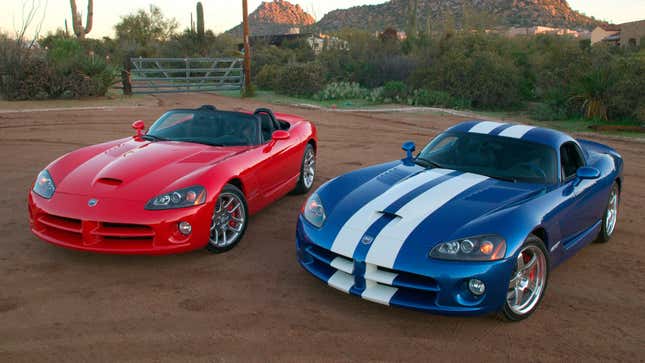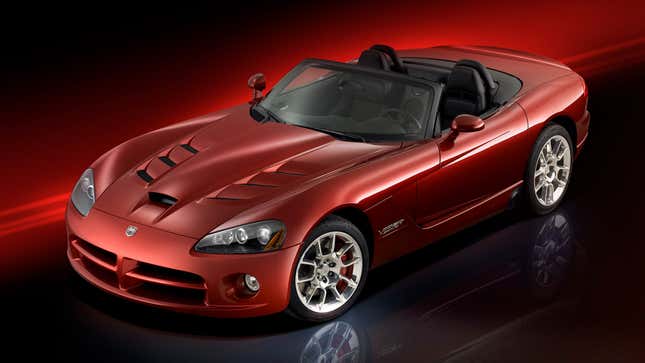I know that to the uninitiated, this seems like a dumb question. If that’s the case, I assume you’ve never met a Viper fan.
Today I unexpectedly hurled myself into a philosophical debate with some friends that inevitably flowed into the Jalopnik Slack, as such quandaries tend to do. Someone asked me how many Viper generations there had been, and I responded the same way I always have and always will: Three.
The first one looked like this:

But it also looked like this, because the GTS was a coupe version of the RT/10. With mechanical changes, sure — don’t worry, we’ll get into those — but ultimately, it was based on the original roadster.

The second Viper looked like this, again roadster and coupe:

And the third one — which is the only generation everyone can seem to agree on as being a singular entity — looked like this:

I think a layperson would agree with the three-generation assertion. Nevertheless, as I’ve found, this appears to be the minority perspective. Ask any Viper enthusiast, and they’ll probably tell you there were five generations of Viper. That’s Dodge’s position, as the official graphic below shows, and Wikipedia says the same.

What I considered the first generation was apparently two — the SR I and SR II. Yes, they look almost exactly the same, but folks separate them based on the repositioned exhaust (out the back rather than the sides) and an increase in power, particularly for the GTS, which jumped from 400 horsepower in the original RT/10 to 450 HP. The GTS also got airbags and a less tragic-looking dashboard.
Dodge said that 90 percent of parts in the GTS were changed from the RT/10 that preceded it. This appears to be one of the go-to reasons proponents cite to justify dividing the first Viper... era? (seriously, what do we call that general design if it’s not a generation, people?) The fact there are supposedly SR II Viper RT/10s that didn’t share the brunt of the GTS’ upgrades sort of blows a hole in this theory to me, but I’m not a Viper devotee.

The rationale is much the same for separating the Vipers that followed into third- and fourth-generation cars. Considered ZB I and ZB II, the latter’s engine increased in size from 8.3 to 8.4 liters, raising output by 100 HP. Indeed, this engine was seriously reworked, as was the exhaust, fuel and electrical systems. The transmission was swapped out for a different Tremec unit, too, all as the exterior remained almost the same save for deeper slats in the hood.
Mercifully, there were no big changes under the sheet metal during the run of the final Viper generation, the VX. That’s honestly a relief, because I don’t know if I could handle it. But you just know the most pedantic Viper fans were all too ready to enforce this taxonomy again, because the Wikipedia page for that car calls it VX I, even though there’s no such thing as a VX II.
You still with me? That’s just about the briefest way I can explain how five generations of a car are borne out of three. And while I’m slightly more open to the idea that there are five Vipers now than I was before I threw myself into this rabbit hole, I’m still largely unconvinced.
Cars get powertrain upgrades within generations, and sometimes those upgrades are reserved for certain trim levels or packages. If we expand the Viper “new engine equals new generation” logic to, say, the C7 Corvette, then the standard Stingray and the ZR-1 are two fundamentally distinct generations. It’s not a system we apply to other nameplates, so why does the Viper get to be different?
To me, a legitimate generational leap has to combine changes to both exterior design and engineering. This would disqualify the five-generation Viper theory in my view, but also, say, the existence of the 11th-gen North American Toyota Corolla, which kind of had the inverse scenario going on. In that case, Toyota essentially transformed the Corolla’s aesthetics and interior materials, while leaving the previous generation’s hardware intact underneath.
Ultimately, enthusiasts can, have and will argue forever and a day about this, and I can understand the five-generations-of-Viper thinking. I mean, this is basically the Ship of Theseus question for cars. There’s no objective right answer here, merely norms and tradition.
So rather than quibble with each other, from now on I’m going to direct my ire at the carmakers themselves, who have been playing fast and loose with the very nature of what constitutes a new generation for decades. No matter what Mitsubishi says, it can’t convince me there were 10 generations of Lancer Evolution — off the top of my head, I can think of four? And what about all the GC Impreza WRX versions?
I’m racking my brain to recall other cars with questionable generational gaps. Feel free to name any that come to your mind below! It’ll be a nice occasional distraction between Viper fans telling me off.